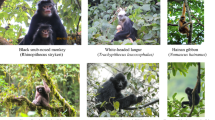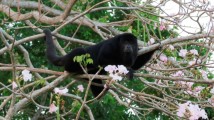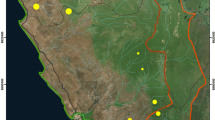Abstract
Large-scale climatic drivers such as El Niño Southern Oscillation (ENSO) can overwhelm factors that ordinarily govern local population dynamics. We recently documented an ENSO-related die-off of mammals in the Kumbhalgarh Wildlife Sanctuary (KWS), Rajasthan, India. This die-off coincided with the La Niña-induced drought of 2000, which followed two consecutive monsoon failures. Hanuman langurs suffered a population crash of nearly 50% from 1999 to 2001. A Multivariate ENSO Index explained 80% of the variability in population size during the time series, and predicted the mass mortality and/or recruitment failure associated with the major La Niña event spanning 1999. Here, we ask whether langurs in a large Rajasthani city, Jodhpur, were buffered against drought because humans provisioned them with food—for religious reasons. Unlike the KWS population, the Jodhpur population suffered no significant decline. In 2001, this urban population remained 95% as large as in 1999, before the drought. Variability in population size was also vastly reduced in Jodhpur. Thus, the impact of drought was dampened in a major urban area compared with an officially protected area. In this case, high human population density was not anathema for conservation. Wildlife sanctuaries in protected areas are undeniably important conservation tools, but our findings reinforce the notion that cities can serve as de facto sanctuaries for some species. This study provides some hope for biodiversity conservation in a rapidly urbanizing world, particularly for holy and commensal species.


Similar content being viewed by others
References
Andersson E (2006) Urban landscapes and sustainable cities. Ecology and Society 11:34. Available at: http://www.ecologyandsociety.org/vol11/iss1/art34/ [accessed January 15, 2007]
Balmford A, Bond W (2005) Trends in the state of nature and their implications for human well-being. Ecology Letters 8:1218–1234
Biquand S, Boug A, Biquand-Guyot V, Gautier JP (1994) Management of commensal baboons in Saudi Arabia. Revue d’Ecologie–La Terre et al Vie 49:213–222
Borries C, Launhardt K, Epplen C, Epplen JT, Winkler P (1999) DNA analyses support the hypothesis that infanticide is adaptive in langur monkeys. Proceedings of the Royal Society of London. Series B: Biological Sciences 266:901–904
Boulton AM, Horrocks JA, Baulu J (1996) The Barbados vervet monkey (Cercopithecus aethiops sabaeus): changes in population size and crop damage, 1980–1994. International Journal of Primatology 17:831–844
Brashares JS, Arcese P, Sam MK (2001) Human demography and reserve size predict wildlife extinction in West Africa. Proceedings of the Royal Society of London. Series B: Biological Sciences 268:2473–2478
Burnham KP, Anderson DR (2002) Model Selection and Multimodel Inference: A Practical Information–Theoretic Approach, 2nd ed.. New York: Springer
Cardillo M, Mace GM, Jones KE, Bielby J, Bininda-Emonds ORP, Sechrest W, et al. (2005) Multiple causes of high extinction risk in large mammal species. Science 309:1239–1241
Cardillo M, Purvis A, Sechrest W, Gittleman JL, Bielby J, Mace GM (2004) Human population density and extinction risk in the world’s carnivores. Public Library of Science, Biology 2:909–914
Cleary DFR, Fauvelot C, Genner MJ, Menken SBJ, Mooers AØ (2006) Parallel responses of species and genetic diversity to El Niño Southern Oscillation-induced environmental destruction. Ecology Letters 9:301–307
Cook WM, Faeth SH (2006) Irrigation and land use drive ground arthropod community patterns in an urban desert. Environmental Entomology 35:1532–1540
Daniels GD, Kirkpatrick JB (2006) Does variation in garden characteristics influence the conservation of birds in suburbia? Biological Conservation 133:326–335
Dobson AP, Lyles AM (1989) The population dynamics and conservation of primate populations. Conservation Biology 3:362–380
Engeman R, Whisson D, Quinn J, Cano F, Quinones P, White TH (2006) Monitoring invasive mammalian predator populations sharing habitat with the critically endangered Puerto Rican parrot Amazona vittata. Oryx 40:95–102
Eudey AA (1994) Temple and pet primates in Thailand. Revue d’Ecologie–La Terre et la Vie 49:273–280
Foley P (1994) Predicting extinction times from environmental stochasticity and carrying capacity. Conservation Biology 8:124–137
Fuentes A (2006) Human culture and monkey behavior: assessing the contexts of potential pathogen transmission between macaques and humans. American Journal of Primatology 68:880–896
Gaston KJ (2005) Biodiversity and extinction: species and people. Progress in Physical Geography 29:239–247
Harrison RD (2000) Repercussions of El Niño: drought causes extinction and the breakdown of mutualism in Borneo. Proceedings of the Royal Society of London. Series B: Biological Sciences 267:911–915
Hill CM (2000) Conflict of interest between people and baboons: Crop raiding in Uganda. International Journal of Primatology 21:299–315
Hill CM (2002) Primate conservation and local communities—ethical issues and debates. American Anthropologist 104:1184–1194
Hrdy SB (1974) Male-male competition and infanticide among the langurs (Presbytis entellus) of Abu, Rajasthan. Folia Primatologia 22:19–58
Jolly A, Dobson A, Rasamimanana HM, Walker J, O’Connor S, Solberg M, et al. (2002) Demography of Lemur catta at Berenty Reserve, Madagascar: effects of troop size, habitat and rainfall. International Journal of Primatology 23:327–353
Jones-Engel L, Engel GA, Heidrich J, Chalise M, Poudel N, Viscidi R, et al. (2006) Temple monkeys and health implications of commensalism, Kathmandu, Nepal. Emerging Infectious Diseases 12:900–906
Knight J (1999) Monkeys on the move: the natural symbolism of people–macaque conflict in Japan. The Journal of Asian Studies 58:622–664
Koenig A, Borries C (2001) Socioecology of Hanuman langurs: the story of their success. Evolutionary Anthropology 10:122–137
Lima M, Stenseth NC, Jaksic FM (2002) Food web structure and climate effects on the dynamics of small mammals and owls in semi-arid Chile. Ecology Letters 5:273–284
Lotts KC, Waite TA, Vucetich JA (2004) Reliability of absolute and relative predictions of population persistence based on time series. Conservation Biology 18:1224–1232
Luck GW, Ricketts TH, Daily GC, Imhoff M (2004) Alleviating spatial conflict between people and biodiversity. Proceedings of the National Academy of Sciences of the United States of America 101:182–186
Marzluff JM, Bowman R, Donnelly R (2001) Avian Conservation and Ecology in an Urbanizing World, Boston: Kluwer Academic Publishers
Miller JR, Hobbs RJ (2002) Conservation where people live and work. Conservation Biology 16:330–337
Nandi JS, Bhavalkar-Potdar V, Tikute S, Rautt CG (2000) A novel type D simian retrovirus naturally infecting the Indian Hanuman langur (Semnopithecus entellus). Virology 277:6–13
Naughton-Treves L, Treves A, Chapman C, Wrangham R (1998) Temporal patterns of crop-raiding by primates: linking food availability in croplands and adjacent forest. Journal of Applied Ecology 35:596–606
Pan RL, Oxnard C (2003) Dental variation among Asian colobines (nonhuman primates): phylogenetic similarities or functional correspondence? Zoological Studies 42:93–105
Rajpurohit LS, Chhangani AK, Mohnot SM (2006) Population dynamics of Hanuman langur, Semnopithecus entellus around Jodhpur (India) during 1995–2001. Proceedings of the National Academy of Science, India 76:141–147
Ramp D, Wilson VK, Croft DB (2006) Assessing the impacts of roads in peri-urban reserves: road-based fatalities and road usage by wildlife in the Royal National Park, New South Wales, Australia. Biological Conservation 129:348–359
Reed DH, O’Grady JJ, Ballou JD, Frankham R (2003) The frequency and severity of catastrophic die-offs in vertebrates. Animal Conservation 6:109–114
Riley SPD, Foley J, Chomel B (2004) Exposure to feline and canine pathogens in bobcats and gray foxes in urban and rural zones of a National Park in California. Journal of Wildlife Diseases 40:11–22
Rosenzweig ML (2003) Win–Win Ecology: How the Earth’s Species Can Survive in the Midst of Human Enterprise, New York: Oxford University Press
Ross C, Srivastava A, Pirta RS (1993) Human influences on the population density of Hanuman langurs Presbytis entellus and Rhesus macaques Macaca mulatta in Shimla, India. Biological Conservation 65:159–163
Saj TL, Sicotte P, Paterson JD (2001) The conflict between vervet monkeys and farmers at the forest edge in Entebbe, Uganda. African Journal of Ecology 39:195–199
Schillaci MA, Jones-Engel L, Engel GA, Kyes RC (2006) Exposure to human respiratory viruses among urban performing monkeys in Indonesia. American Journal of Tropical Medicine and Hygiene 75:716–719
Singh H, Mishra D, Nahar NM, Ranjan M (2003) Energy use pattern in production agriculture of a typical village in and zone India: part II. Energy Conversion and Management 44:1053–1067
Singh M, Rao NR (2004) Population dynamics and conservation of commensal Bonnet macaques. International Journal of Primatology 25:847–859
Sitati NW, Walpole MJ (2006) Assessing farm-based measures for mitigating human–elephant conflict in Transmara District, Kenya. Oryx 40:279–286
Southwick CH, Siddiqi MF (1994) Primate commensalism: the rhesus monkey in India. Revue d’Ecologie–La Terre et al Vie 49:223–231
SPSS (2005) SPSS, version 14.0, Chicago: SPSS, Inc
SYSTAT (2004) SYSTAT, version 11.00.01, Richmond: SYSTAT Software, Inc
Thomas CD, Cameron A, Green RE, Bakkenes M, Beaumont LJ, Collingham YC, et al. (2004) Extinction risk from climate change. Nature 427:145–148
Tomalin E (2004) Bio-divinity and biodiversity: perspectives on religion and environmental conservation in India. Numen-International Review for the History of Religions 51:265–295
UNEP–WCMC (2006) World Database on Protected Areas. Available at: http://sea.unep-wcmc.org/wdbpa [accessed January 7, 2007]
Vucetich JA, Smith DW, Stahler DR (2005) Influence of harvest, climate and wolf predation on Yellowstone elk, 1961–2004. Oikos 111:259–270
Vucetich JA, Waite TA (1998) On the interpretation and application of mean times to extinction. Biodiversity Conservation 7:1539–1547
Waite TA, Campbell LG, Chhangani AK, Robbins P (2007) La Niña’s signature: synchronous decline of the mammal community in a ‘protected’ area in India. Divers Distrib (in press)
Waite TA (2007) Revisiting evidence for sustainability of bushmeat hunting in West Africa. Environ Manage (in press)
Waite TA, Strickland D (2006) Climate change and the demographic demise of a hoarding bird living on the edge. Proceedings of the Royal Society of London. Series B: Biological Sciences 273:2809–2813
West P, Igoe J, Brockington D (2006) Parks and peoples: the social impact of protected areas. Annual Review of Anthropology 35:251–277
Wheatley BP, Putra DKH (1994) The effects of tourism on conservation at The Monkey Forest in Ubud, Bali. Revue D’Ecology–La Terre et la Vie 49:245–257
Wiley JP (1999) It’s fun—and a real pain—when monkeys move to town. Smithsonian 29:102–109
Willis MS, Swindler DR (2004) Molar size and shape variations among Asian colobines. American Journal of Physical Anthropology 125:51–60
Wilmers CC, Post E, Peterson RO, Vucetich JA (2006) Predator disease out-break modulates top-down, bottom-up and climatic effects on herbivore population dynamics. Ecology Letters 9:383–389
Acknowledgments
We thank R. Malhotra, PCCF, L. Ranawat, and B. Singh, ACF, for granting permission to work in KWS; USFWS and Ministry of Environment and Forests for supporting the Indo–US Primate Project; D. Ferguson and C. Southwick for advice; P. Robbins for related collaboration; many support personnel; and S. Corey and two reviewers for helpful comments on the manuscript. This work was supported by NSF grant 0351037.
Author information
Authors and Affiliations
Corresponding author
Rights and permissions
About this article
Cite this article
Waite, T.A., Chhangani, A.K., Campbell, L.G. et al. Sanctuary in the City: Urban Monkeys Buffered against Catastrophic Die-off during ENSO-related Drought. EcoHealth 4, 278–286 (2007). https://doi.org/10.1007/s10393-007-0112-6
Published:
Issue Date:
DOI: https://doi.org/10.1007/s10393-007-0112-6




